Comprehensive Analysis of Teaching Methods - Course 8601
VerifiedAdded on 2021/10/14
|21
|6741
|141
Homework Assignment
AI Summary
This document presents a comprehensive solution to a teaching methods assignment, addressing key concepts such as defining effective teaching, and the elements of a conducive learning environment. It explores the merits of lesson planning, differentiating between inductive and deductive methods, and outlining limitations of the activity-based teaching method. The assignment further delves into lesson planning, describing classical models and their implementation. It covers various aspects of lesson planning, including learning objectives, activities, and assessments, while also highlighting the integration of subjects and the progression of course material. The document provides a detailed overview of the subject matter, offering valuable insights into the principles and practices of effective teaching.
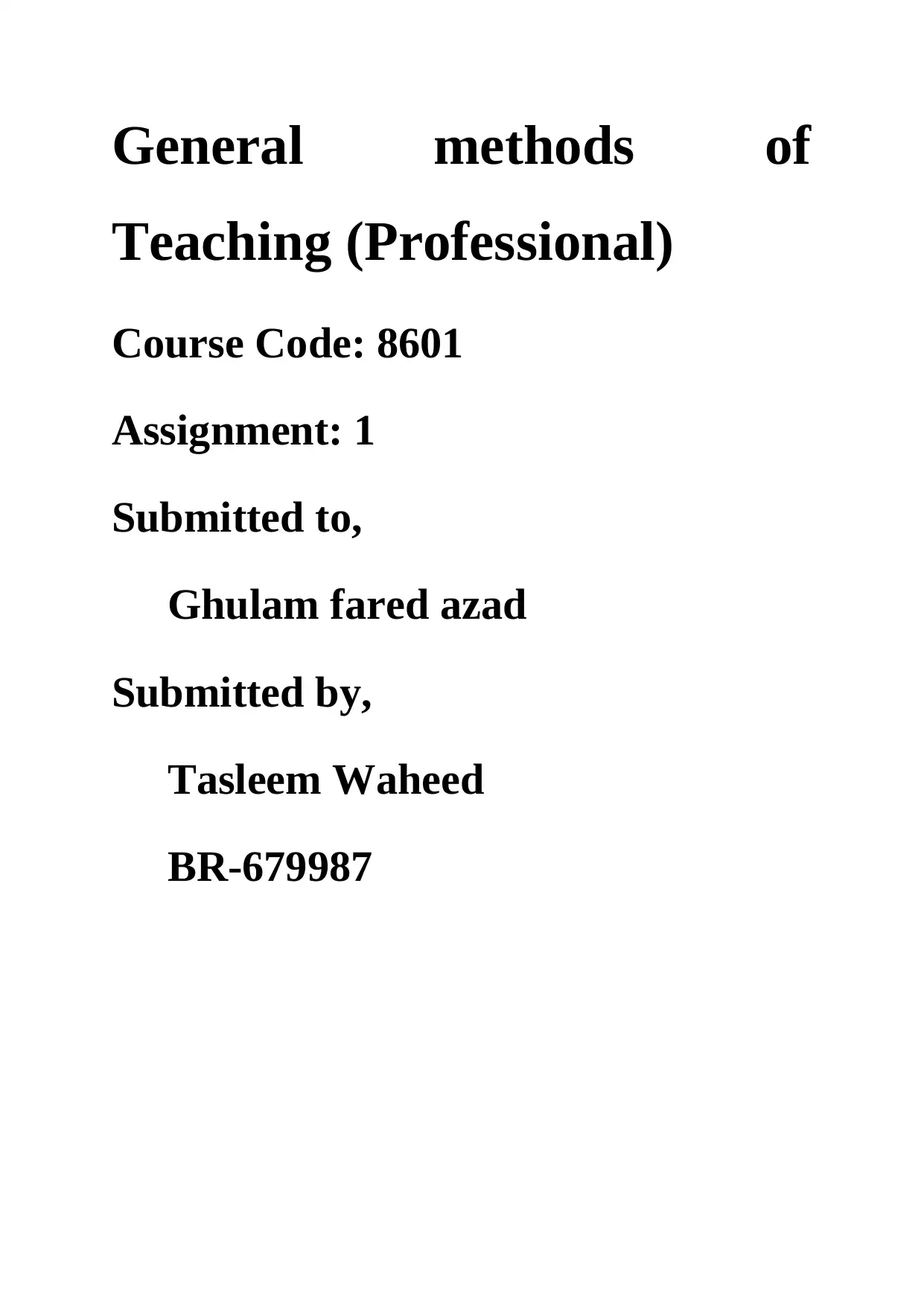
General methods of
Teaching (Professional)
Course Code: 8601
Assignment: 1
Submitted to,
Ghulam fared azad
Submitted by,
Tasleem Waheed
BR-679987
Teaching (Professional)
Course Code: 8601
Assignment: 1
Submitted to,
Ghulam fared azad
Submitted by,
Tasleem Waheed
BR-679987
Paraphrase This Document
Need a fresh take? Get an instant paraphrase of this document with our AI Paraphraser
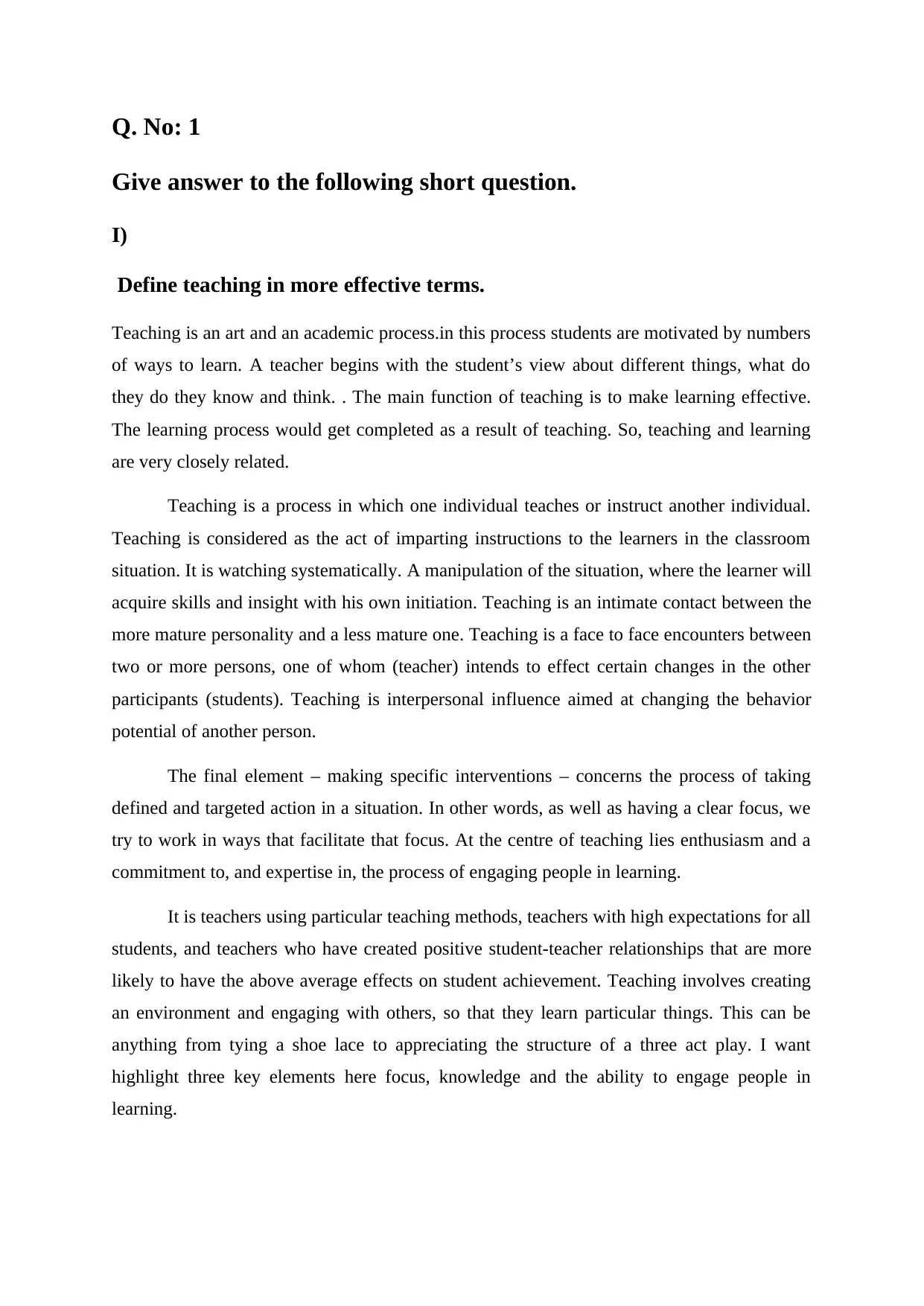
Q. No: 1
Give answer to the following short question.
I)
Define teaching in more effective terms.
Teaching is an art and an academic process.in this process students are motivated by numbers
of ways to learn. A teacher begins with the student’s view about different things, what do
they do they know and think. . The main function of teaching is to make learning effective.
The learning process would get completed as a result of teaching. So, teaching and learning
are very closely related.
Teaching is a process in which one individual teaches or instruct another individual.
Teaching is considered as the act of imparting instructions to the learners in the classroom
situation. It is watching systematically. A manipulation of the situation, where the learner will
acquire skills and insight with his own initiation. Teaching is an intimate contact between the
more mature personality and a less mature one. Teaching is a face to face encounters between
two or more persons, one of whom (teacher) intends to effect certain changes in the other
participants (students). Teaching is interpersonal influence aimed at changing the behavior
potential of another person.
The final element – making specific interventions – concerns the process of taking
defined and targeted action in a situation. In other words, as well as having a clear focus, we
try to work in ways that facilitate that focus. At the centre of teaching lies enthusiasm and a
commitment to, and expertise in, the process of engaging people in learning.
It is teachers using particular teaching methods, teachers with high expectations for all
students, and teachers who have created positive student-teacher relationships that are more
likely to have the above average effects on student achievement. Teaching involves creating
an environment and engaging with others, so that they learn particular things. This can be
anything from tying a shoe lace to appreciating the structure of a three act play. I want
highlight three key elements here focus, knowledge and the ability to engage people in
learning.
Give answer to the following short question.
I)
Define teaching in more effective terms.
Teaching is an art and an academic process.in this process students are motivated by numbers
of ways to learn. A teacher begins with the student’s view about different things, what do
they do they know and think. . The main function of teaching is to make learning effective.
The learning process would get completed as a result of teaching. So, teaching and learning
are very closely related.
Teaching is a process in which one individual teaches or instruct another individual.
Teaching is considered as the act of imparting instructions to the learners in the classroom
situation. It is watching systematically. A manipulation of the situation, where the learner will
acquire skills and insight with his own initiation. Teaching is an intimate contact between the
more mature personality and a less mature one. Teaching is a face to face encounters between
two or more persons, one of whom (teacher) intends to effect certain changes in the other
participants (students). Teaching is interpersonal influence aimed at changing the behavior
potential of another person.
The final element – making specific interventions – concerns the process of taking
defined and targeted action in a situation. In other words, as well as having a clear focus, we
try to work in ways that facilitate that focus. At the centre of teaching lies enthusiasm and a
commitment to, and expertise in, the process of engaging people in learning.
It is teachers using particular teaching methods, teachers with high expectations for all
students, and teachers who have created positive student-teacher relationships that are more
likely to have the above average effects on student achievement. Teaching involves creating
an environment and engaging with others, so that they learn particular things. This can be
anything from tying a shoe lace to appreciating the structure of a three act play. I want
highlight three key elements here focus, knowledge and the ability to engage people in
learning.
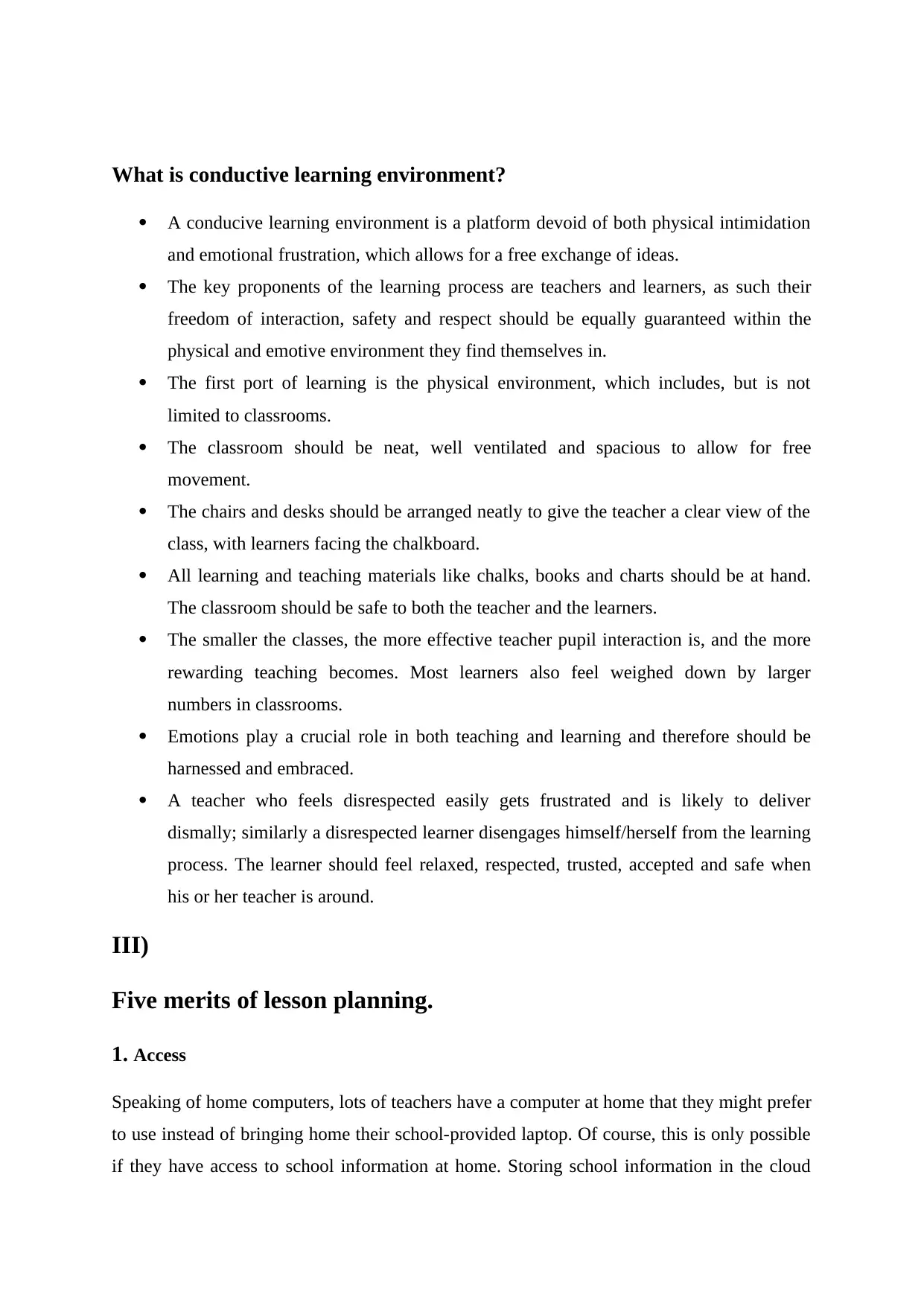
What is conductive learning environment?
A conducive learning environment is a platform devoid of both physical intimidation
and emotional frustration, which allows for a free exchange of ideas.
The key proponents of the learning process are teachers and learners, as such their
freedom of interaction, safety and respect should be equally guaranteed within the
physical and emotive environment they find themselves in.
The first port of learning is the physical environment, which includes, but is not
limited to classrooms.
The classroom should be neat, well ventilated and spacious to allow for free
movement.
The chairs and desks should be arranged neatly to give the teacher a clear view of the
class, with learners facing the chalkboard.
All learning and teaching materials like chalks, books and charts should be at hand.
The classroom should be safe to both the teacher and the learners.
The smaller the classes, the more effective teacher pupil interaction is, and the more
rewarding teaching becomes. Most learners also feel weighed down by larger
numbers in classrooms.
Emotions play a crucial role in both teaching and learning and therefore should be
harnessed and embraced.
A teacher who feels disrespected easily gets frustrated and is likely to deliver
dismally; similarly a disrespected learner disengages himself/herself from the learning
process. The learner should feel relaxed, respected, trusted, accepted and safe when
his or her teacher is around.
III)
Five merits of lesson planning.
1. Access
Speaking of home computers, lots of teachers have a computer at home that they might prefer
to use instead of bringing home their school-provided laptop. Of course, this is only possible
if they have access to school information at home. Storing school information in the cloud
A conducive learning environment is a platform devoid of both physical intimidation
and emotional frustration, which allows for a free exchange of ideas.
The key proponents of the learning process are teachers and learners, as such their
freedom of interaction, safety and respect should be equally guaranteed within the
physical and emotive environment they find themselves in.
The first port of learning is the physical environment, which includes, but is not
limited to classrooms.
The classroom should be neat, well ventilated and spacious to allow for free
movement.
The chairs and desks should be arranged neatly to give the teacher a clear view of the
class, with learners facing the chalkboard.
All learning and teaching materials like chalks, books and charts should be at hand.
The classroom should be safe to both the teacher and the learners.
The smaller the classes, the more effective teacher pupil interaction is, and the more
rewarding teaching becomes. Most learners also feel weighed down by larger
numbers in classrooms.
Emotions play a crucial role in both teaching and learning and therefore should be
harnessed and embraced.
A teacher who feels disrespected easily gets frustrated and is likely to deliver
dismally; similarly a disrespected learner disengages himself/herself from the learning
process. The learner should feel relaxed, respected, trusted, accepted and safe when
his or her teacher is around.
III)
Five merits of lesson planning.
1. Access
Speaking of home computers, lots of teachers have a computer at home that they might prefer
to use instead of bringing home their school-provided laptop. Of course, this is only possible
if they have access to school information at home. Storing school information in the cloud
⊘ This is a preview!⊘
Do you want full access?
Subscribe today to unlock all pages.

Trusted by 1+ million students worldwide
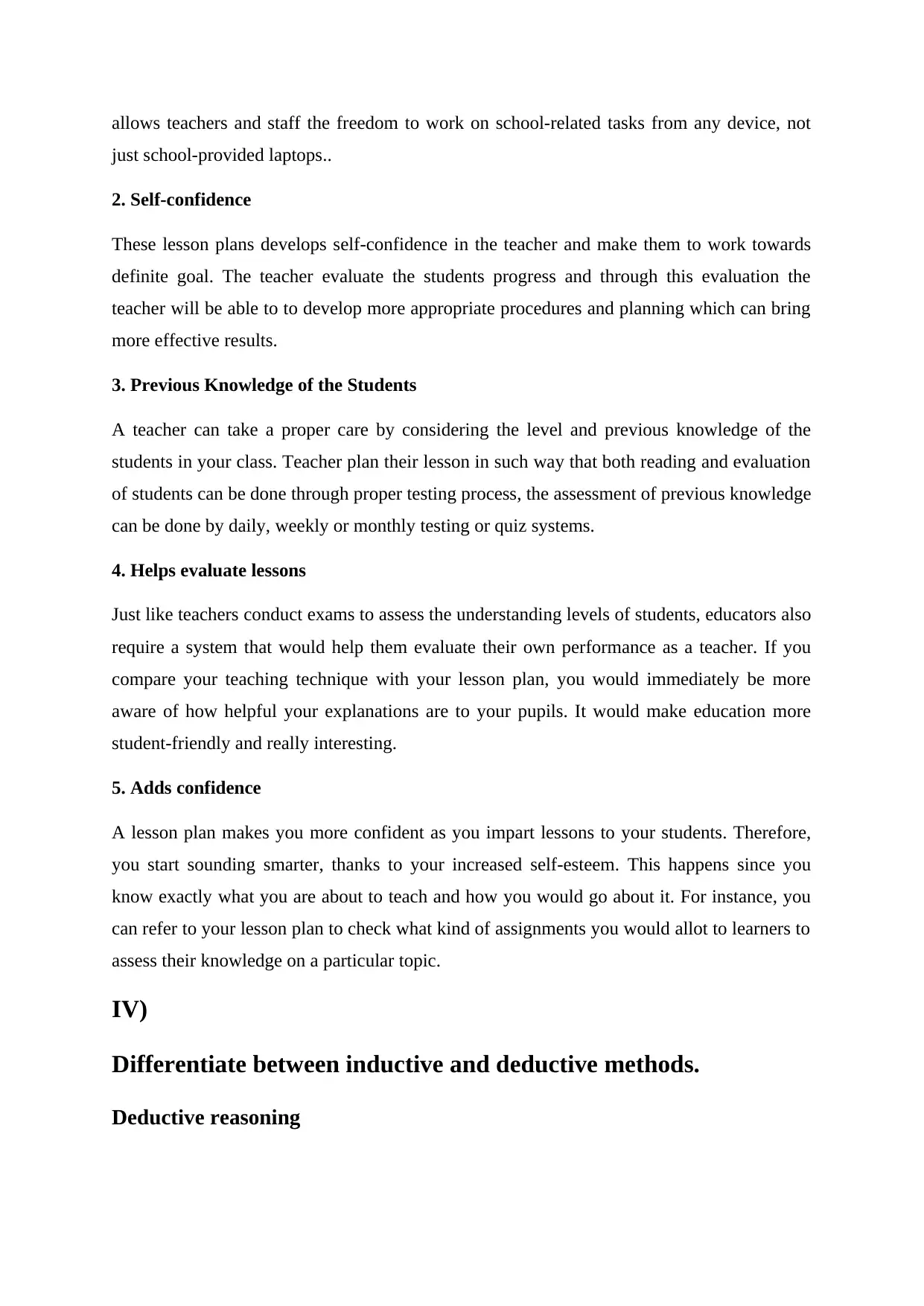
allows teachers and staff the freedom to work on school-related tasks from any device, not
just school-provided laptops..
2. Self-confidence
These lesson plans develops self-confidence in the teacher and make them to work towards
definite goal. The teacher evaluate the students progress and through this evaluation the
teacher will be able to to develop more appropriate procedures and planning which can bring
more effective results.
3. Previous Knowledge of the Students
A teacher can take a proper care by considering the level and previous knowledge of the
students in your class. Teacher plan their lesson in such way that both reading and evaluation
of students can be done through proper testing process, the assessment of previous knowledge
can be done by daily, weekly or monthly testing or quiz systems.
4. Helps evaluate lessons
Just like teachers conduct exams to assess the understanding levels of students, educators also
require a system that would help them evaluate their own performance as a teacher. If you
compare your teaching technique with your lesson plan, you would immediately be more
aware of how helpful your explanations are to your pupils. It would make education more
student-friendly and really interesting.
5. Adds confidence
A lesson plan makes you more confident as you impart lessons to your students. Therefore,
you start sounding smarter, thanks to your increased self-esteem. This happens since you
know exactly what you are about to teach and how you would go about it. For instance, you
can refer to your lesson plan to check what kind of assignments you would allot to learners to
assess their knowledge on a particular topic.
IV)
Differentiate between inductive and deductive methods.
Deductive reasoning
just school-provided laptops..
2. Self-confidence
These lesson plans develops self-confidence in the teacher and make them to work towards
definite goal. The teacher evaluate the students progress and through this evaluation the
teacher will be able to to develop more appropriate procedures and planning which can bring
more effective results.
3. Previous Knowledge of the Students
A teacher can take a proper care by considering the level and previous knowledge of the
students in your class. Teacher plan their lesson in such way that both reading and evaluation
of students can be done through proper testing process, the assessment of previous knowledge
can be done by daily, weekly or monthly testing or quiz systems.
4. Helps evaluate lessons
Just like teachers conduct exams to assess the understanding levels of students, educators also
require a system that would help them evaluate their own performance as a teacher. If you
compare your teaching technique with your lesson plan, you would immediately be more
aware of how helpful your explanations are to your pupils. It would make education more
student-friendly and really interesting.
5. Adds confidence
A lesson plan makes you more confident as you impart lessons to your students. Therefore,
you start sounding smarter, thanks to your increased self-esteem. This happens since you
know exactly what you are about to teach and how you would go about it. For instance, you
can refer to your lesson plan to check what kind of assignments you would allot to learners to
assess their knowledge on a particular topic.
IV)
Differentiate between inductive and deductive methods.
Deductive reasoning
Paraphrase This Document
Need a fresh take? Get an instant paraphrase of this document with our AI Paraphraser
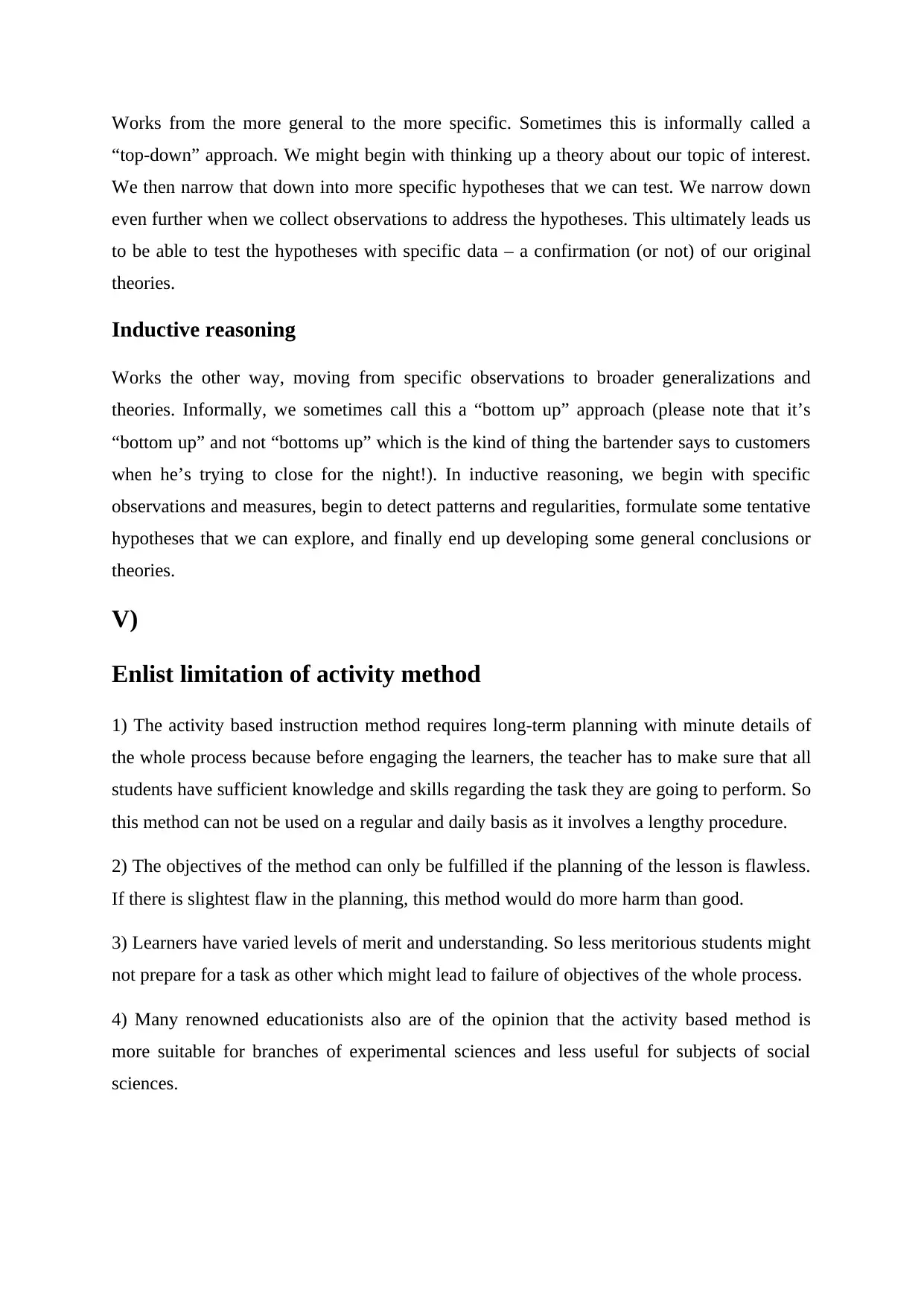
Works from the more general to the more specific. Sometimes this is informally called a
“top-down” approach. We might begin with thinking up a theory about our topic of interest.
We then narrow that down into more specific hypotheses that we can test. We narrow down
even further when we collect observations to address the hypotheses. This ultimately leads us
to be able to test the hypotheses with specific data – a confirmation (or not) of our original
theories.
Inductive reasoning
Works the other way, moving from specific observations to broader generalizations and
theories. Informally, we sometimes call this a “bottom up” approach (please note that it’s
“bottom up” and not “bottoms up” which is the kind of thing the bartender says to customers
when he’s trying to close for the night!). In inductive reasoning, we begin with specific
observations and measures, begin to detect patterns and regularities, formulate some tentative
hypotheses that we can explore, and finally end up developing some general conclusions or
theories.
V)
Enlist limitation of activity method
1) The activity based instruction method requires long-term planning with minute details of
the whole process because before engaging the learners, the teacher has to make sure that all
students have sufficient knowledge and skills regarding the task they are going to perform. So
this method can not be used on a regular and daily basis as it involves a lengthy procedure.
2) The objectives of the method can only be fulfilled if the planning of the lesson is flawless.
If there is slightest flaw in the planning, this method would do more harm than good.
3) Learners have varied levels of merit and understanding. So less meritorious students might
not prepare for a task as other which might lead to failure of objectives of the whole process.
4) Many renowned educationists also are of the opinion that the activity based method is
more suitable for branches of experimental sciences and less useful for subjects of social
sciences.
“top-down” approach. We might begin with thinking up a theory about our topic of interest.
We then narrow that down into more specific hypotheses that we can test. We narrow down
even further when we collect observations to address the hypotheses. This ultimately leads us
to be able to test the hypotheses with specific data – a confirmation (or not) of our original
theories.
Inductive reasoning
Works the other way, moving from specific observations to broader generalizations and
theories. Informally, we sometimes call this a “bottom up” approach (please note that it’s
“bottom up” and not “bottoms up” which is the kind of thing the bartender says to customers
when he’s trying to close for the night!). In inductive reasoning, we begin with specific
observations and measures, begin to detect patterns and regularities, formulate some tentative
hypotheses that we can explore, and finally end up developing some general conclusions or
theories.
V)
Enlist limitation of activity method
1) The activity based instruction method requires long-term planning with minute details of
the whole process because before engaging the learners, the teacher has to make sure that all
students have sufficient knowledge and skills regarding the task they are going to perform. So
this method can not be used on a regular and daily basis as it involves a lengthy procedure.
2) The objectives of the method can only be fulfilled if the planning of the lesson is flawless.
If there is slightest flaw in the planning, this method would do more harm than good.
3) Learners have varied levels of merit and understanding. So less meritorious students might
not prepare for a task as other which might lead to failure of objectives of the whole process.
4) Many renowned educationists also are of the opinion that the activity based method is
more suitable for branches of experimental sciences and less useful for subjects of social
sciences.
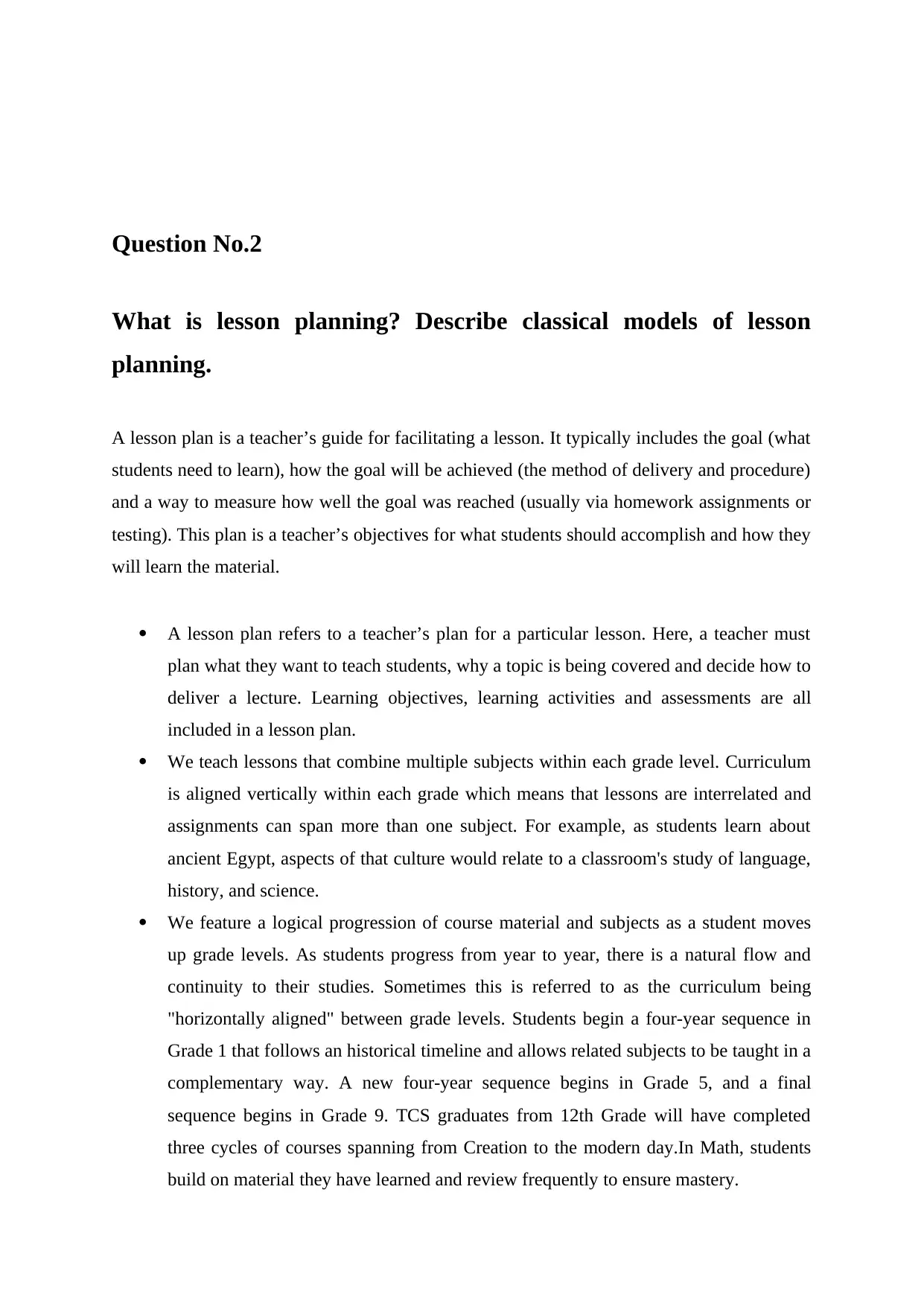
Question No.2
What is lesson planning? Describe classical models of lesson
planning.
A lesson plan is a teacher’s guide for facilitating a lesson. It typically includes the goal (what
students need to learn), how the goal will be achieved (the method of delivery and procedure)
and a way to measure how well the goal was reached (usually via homework assignments or
testing). This plan is a teacher’s objectives for what students should accomplish and how they
will learn the material.
A lesson plan refers to a teacher’s plan for a particular lesson. Here, a teacher must
plan what they want to teach students, why a topic is being covered and decide how to
deliver a lecture. Learning objectives, learning activities and assessments are all
included in a lesson plan.
We teach lessons that combine multiple subjects within each grade level. Curriculum
is aligned vertically within each grade which means that lessons are interrelated and
assignments can span more than one subject. For example, as students learn about
ancient Egypt, aspects of that culture would relate to a classroom's study of language,
history, and science.
We feature a logical progression of course material and subjects as a student moves
up grade levels. As students progress from year to year, there is a natural flow and
continuity to their studies. Sometimes this is referred to as the curriculum being
"horizontally aligned" between grade levels. Students begin a four-year sequence in
Grade 1 that follows an historical timeline and allows related subjects to be taught in a
complementary way. A new four-year sequence begins in Grade 5, and a final
sequence begins in Grade 9. TCS graduates from 12th Grade will have completed
three cycles of courses spanning from Creation to the modern day.In Math, students
build on material they have learned and review frequently to ensure mastery.
What is lesson planning? Describe classical models of lesson
planning.
A lesson plan is a teacher’s guide for facilitating a lesson. It typically includes the goal (what
students need to learn), how the goal will be achieved (the method of delivery and procedure)
and a way to measure how well the goal was reached (usually via homework assignments or
testing). This plan is a teacher’s objectives for what students should accomplish and how they
will learn the material.
A lesson plan refers to a teacher’s plan for a particular lesson. Here, a teacher must
plan what they want to teach students, why a topic is being covered and decide how to
deliver a lecture. Learning objectives, learning activities and assessments are all
included in a lesson plan.
We teach lessons that combine multiple subjects within each grade level. Curriculum
is aligned vertically within each grade which means that lessons are interrelated and
assignments can span more than one subject. For example, as students learn about
ancient Egypt, aspects of that culture would relate to a classroom's study of language,
history, and science.
We feature a logical progression of course material and subjects as a student moves
up grade levels. As students progress from year to year, there is a natural flow and
continuity to their studies. Sometimes this is referred to as the curriculum being
"horizontally aligned" between grade levels. Students begin a four-year sequence in
Grade 1 that follows an historical timeline and allows related subjects to be taught in a
complementary way. A new four-year sequence begins in Grade 5, and a final
sequence begins in Grade 9. TCS graduates from 12th Grade will have completed
three cycles of courses spanning from Creation to the modern day.In Math, students
build on material they have learned and review frequently to ensure mastery.
⊘ This is a preview!⊘
Do you want full access?
Subscribe today to unlock all pages.

Trusted by 1+ million students worldwide
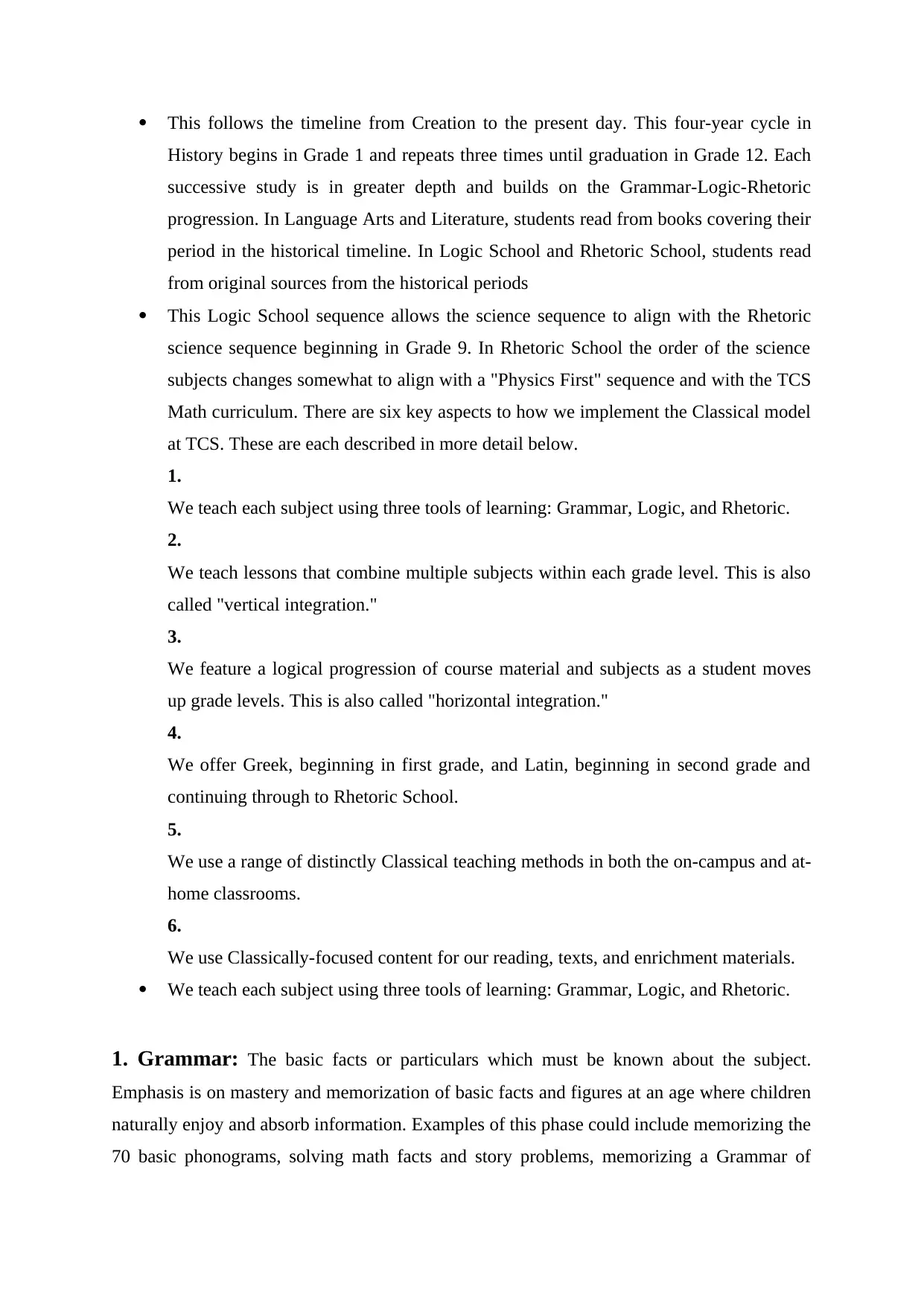
This follows the timeline from Creation to the present day. This four-year cycle in
History begins in Grade 1 and repeats three times until graduation in Grade 12. Each
successive study is in greater depth and builds on the Grammar-Logic-Rhetoric
progression. In Language Arts and Literature, students read from books covering their
period in the historical timeline. In Logic School and Rhetoric School, students read
from original sources from the historical periods
This Logic School sequence allows the science sequence to align with the Rhetoric
science sequence beginning in Grade 9. In Rhetoric School the order of the science
subjects changes somewhat to align with a "Physics First" sequence and with the TCS
Math curriculum. There are six key aspects to how we implement the Classical model
at TCS. These are each described in more detail below.
1.
We teach each subject using three tools of learning: Grammar, Logic, and Rhetoric.
2.
We teach lessons that combine multiple subjects within each grade level. This is also
called "vertical integration."
3.
We feature a logical progression of course material and subjects as a student moves
up grade levels. This is also called "horizontal integration."
4.
We offer Greek, beginning in first grade, and Latin, beginning in second grade and
continuing through to Rhetoric School.
5.
We use a range of distinctly Classical teaching methods in both the on-campus and at-
home classrooms.
6.
We use Classically-focused content for our reading, texts, and enrichment materials.
We teach each subject using three tools of learning: Grammar, Logic, and Rhetoric.
1. Grammar: The basic facts or particulars which must be known about the subject.
Emphasis is on mastery and memorization of basic facts and figures at an age where children
naturally enjoy and absorb information. Examples of this phase could include memorizing the
70 basic phonograms, solving math facts and story problems, memorizing a Grammar of
History begins in Grade 1 and repeats three times until graduation in Grade 12. Each
successive study is in greater depth and builds on the Grammar-Logic-Rhetoric
progression. In Language Arts and Literature, students read from books covering their
period in the historical timeline. In Logic School and Rhetoric School, students read
from original sources from the historical periods
This Logic School sequence allows the science sequence to align with the Rhetoric
science sequence beginning in Grade 9. In Rhetoric School the order of the science
subjects changes somewhat to align with a "Physics First" sequence and with the TCS
Math curriculum. There are six key aspects to how we implement the Classical model
at TCS. These are each described in more detail below.
1.
We teach each subject using three tools of learning: Grammar, Logic, and Rhetoric.
2.
We teach lessons that combine multiple subjects within each grade level. This is also
called "vertical integration."
3.
We feature a logical progression of course material and subjects as a student moves
up grade levels. This is also called "horizontal integration."
4.
We offer Greek, beginning in first grade, and Latin, beginning in second grade and
continuing through to Rhetoric School.
5.
We use a range of distinctly Classical teaching methods in both the on-campus and at-
home classrooms.
6.
We use Classically-focused content for our reading, texts, and enrichment materials.
We teach each subject using three tools of learning: Grammar, Logic, and Rhetoric.
1. Grammar: The basic facts or particulars which must be known about the subject.
Emphasis is on mastery and memorization of basic facts and figures at an age where children
naturally enjoy and absorb information. Examples of this phase could include memorizing the
70 basic phonograms, solving math facts and story problems, memorizing a Grammar of
Paraphrase This Document
Need a fresh take? Get an instant paraphrase of this document with our AI Paraphraser
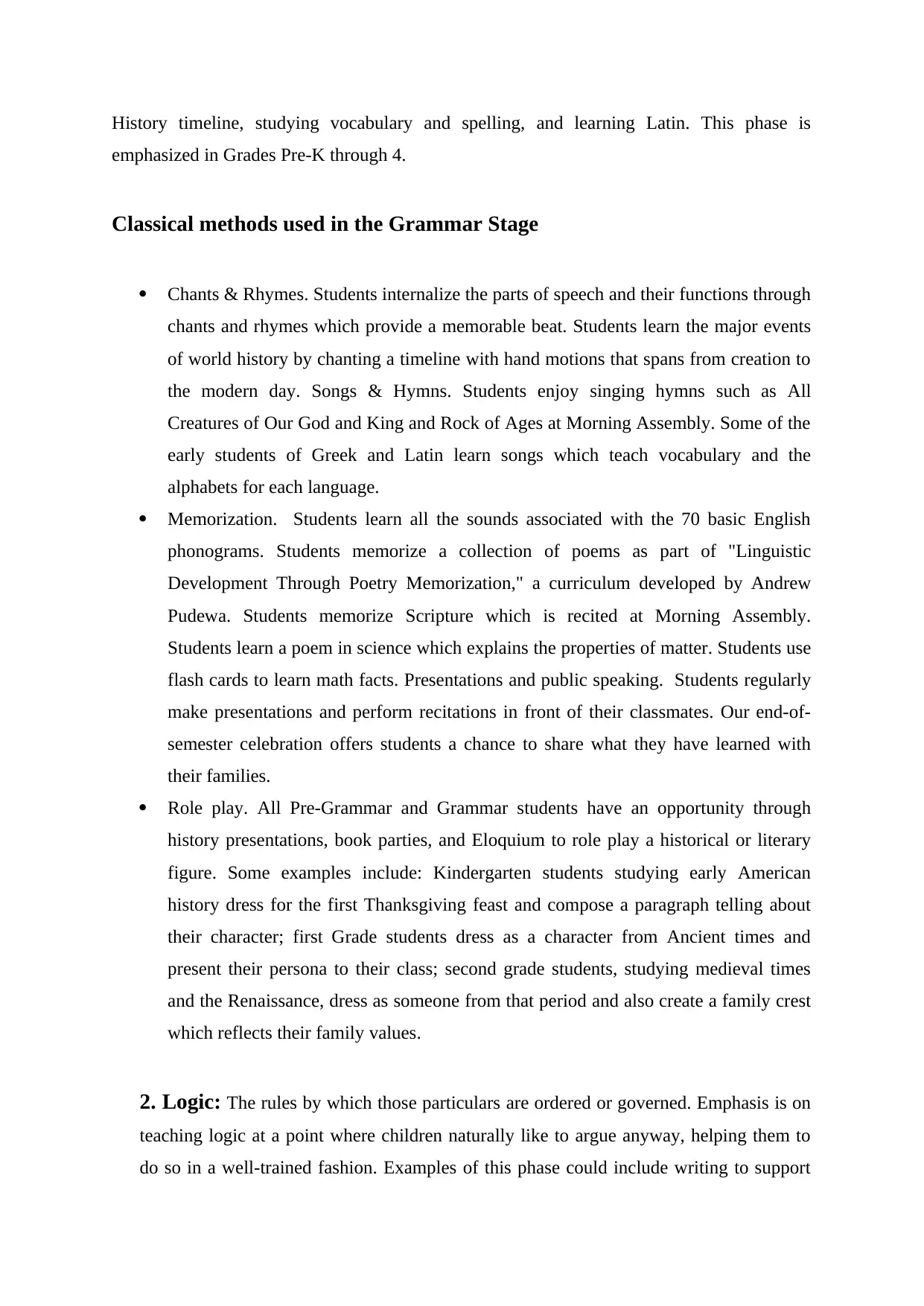
History timeline, studying vocabulary and spelling, and learning Latin. This phase is
emphasized in Grades Pre-K through 4.
Classical methods used in the Grammar Stage
Chants & Rhymes. Students internalize the parts of speech and their functions through
chants and rhymes which provide a memorable beat. Students learn the major events
of world history by chanting a timeline with hand motions that spans from creation to
the modern day. Songs & Hymns. Students enjoy singing hymns such as All
Creatures of Our God and King and Rock of Ages at Morning Assembly. Some of the
early students of Greek and Latin learn songs which teach vocabulary and the
alphabets for each language.
Memorization. Students learn all the sounds associated with the 70 basic English
phonograms. Students memorize a collection of poems as part of "Linguistic
Development Through Poetry Memorization," a curriculum developed by Andrew
Pudewa. Students memorize Scripture which is recited at Morning Assembly.
Students learn a poem in science which explains the properties of matter. Students use
flash cards to learn math facts. Presentations and public speaking. Students regularly
make presentations and perform recitations in front of their classmates. Our end-of-
semester celebration offers students a chance to share what they have learned with
their families.
Role play. All Pre-Grammar and Grammar students have an opportunity through
history presentations, book parties, and Eloquium to role play a historical or literary
figure. Some examples include: Kindergarten students studying early American
history dress for the first Thanksgiving feast and compose a paragraph telling about
their character; first Grade students dress as a character from Ancient times and
present their persona to their class; second grade students, studying medieval times
and the Renaissance, dress as someone from that period and also create a family crest
which reflects their family values.
2. Logic: The rules by which those particulars are ordered or governed. Emphasis is on
teaching logic at a point where children naturally like to argue anyway, helping them to
do so in a well-trained fashion. Examples of this phase could include writing to support
emphasized in Grades Pre-K through 4.
Classical methods used in the Grammar Stage
Chants & Rhymes. Students internalize the parts of speech and their functions through
chants and rhymes which provide a memorable beat. Students learn the major events
of world history by chanting a timeline with hand motions that spans from creation to
the modern day. Songs & Hymns. Students enjoy singing hymns such as All
Creatures of Our God and King and Rock of Ages at Morning Assembly. Some of the
early students of Greek and Latin learn songs which teach vocabulary and the
alphabets for each language.
Memorization. Students learn all the sounds associated with the 70 basic English
phonograms. Students memorize a collection of poems as part of "Linguistic
Development Through Poetry Memorization," a curriculum developed by Andrew
Pudewa. Students memorize Scripture which is recited at Morning Assembly.
Students learn a poem in science which explains the properties of matter. Students use
flash cards to learn math facts. Presentations and public speaking. Students regularly
make presentations and perform recitations in front of their classmates. Our end-of-
semester celebration offers students a chance to share what they have learned with
their families.
Role play. All Pre-Grammar and Grammar students have an opportunity through
history presentations, book parties, and Eloquium to role play a historical or literary
figure. Some examples include: Kindergarten students studying early American
history dress for the first Thanksgiving feast and compose a paragraph telling about
their character; first Grade students dress as a character from Ancient times and
present their persona to their class; second grade students, studying medieval times
and the Renaissance, dress as someone from that period and also create a family crest
which reflects their family values.
2. Logic: The rules by which those particulars are ordered or governed. Emphasis is on
teaching logic at a point where children naturally like to argue anyway, helping them to
do so in a well-trained fashion. Examples of this phase could include writing to support
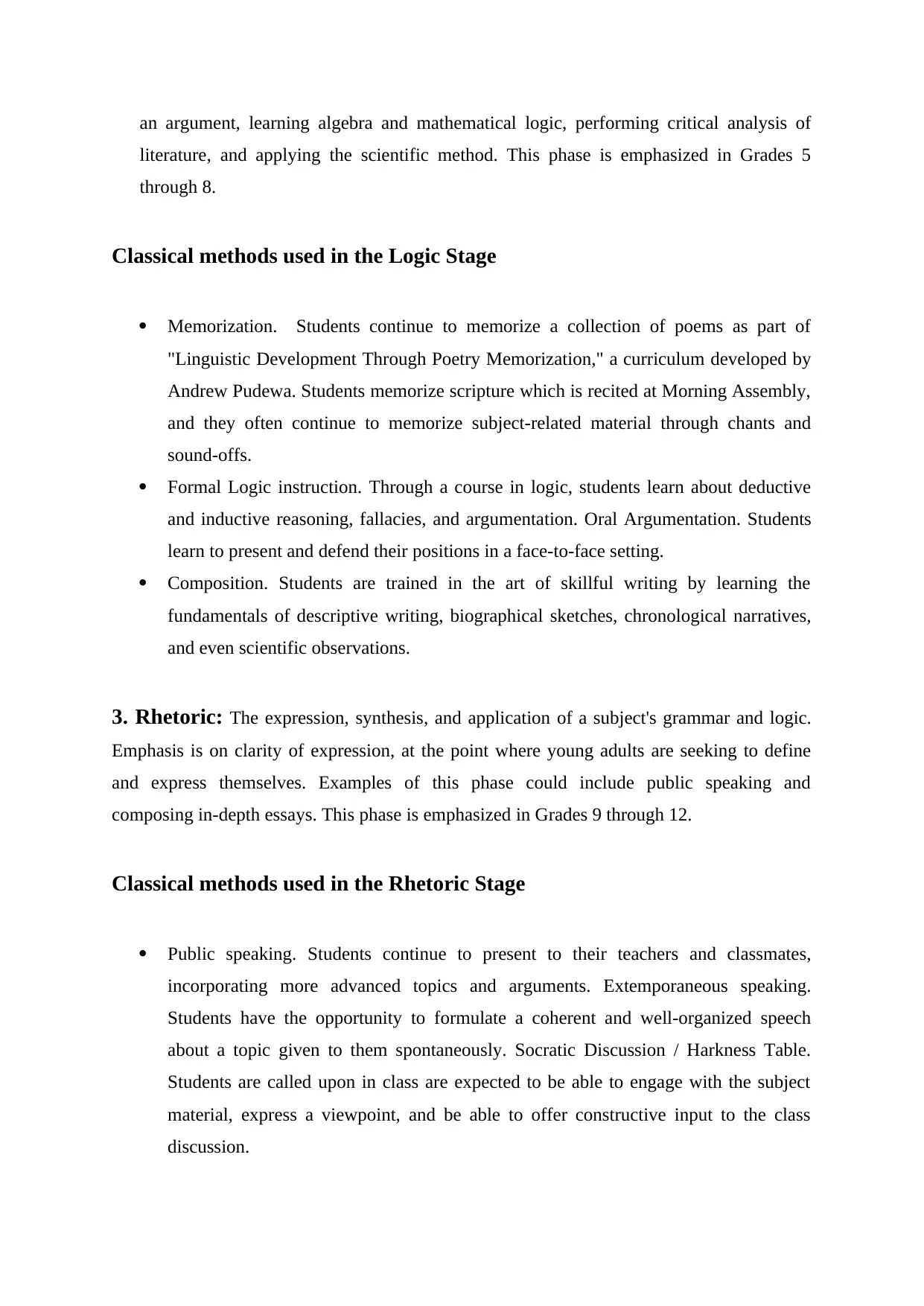
an argument, learning algebra and mathematical logic, performing critical analysis of
literature, and applying the scientific method. This phase is emphasized in Grades 5
through 8.
Classical methods used in the Logic Stage
Memorization. Students continue to memorize a collection of poems as part of
"Linguistic Development Through Poetry Memorization," a curriculum developed by
Andrew Pudewa. Students memorize scripture which is recited at Morning Assembly,
and they often continue to memorize subject-related material through chants and
sound-offs.
Formal Logic instruction. Through a course in logic, students learn about deductive
and inductive reasoning, fallacies, and argumentation. Oral Argumentation. Students
learn to present and defend their positions in a face-to-face setting.
Composition. Students are trained in the art of skillful writing by learning the
fundamentals of descriptive writing, biographical sketches, chronological narratives,
and even scientific observations.
3. Rhetoric: The expression, synthesis, and application of a subject's grammar and logic.
Emphasis is on clarity of expression, at the point where young adults are seeking to define
and express themselves. Examples of this phase could include public speaking and
composing in-depth essays. This phase is emphasized in Grades 9 through 12.
Classical methods used in the Rhetoric Stage
Public speaking. Students continue to present to their teachers and classmates,
incorporating more advanced topics and arguments. Extemporaneous speaking.
Students have the opportunity to formulate a coherent and well-organized speech
about a topic given to them spontaneously. Socratic Discussion / Harkness Table.
Students are called upon in class are expected to be able to engage with the subject
material, express a viewpoint, and be able to offer constructive input to the class
discussion.
literature, and applying the scientific method. This phase is emphasized in Grades 5
through 8.
Classical methods used in the Logic Stage
Memorization. Students continue to memorize a collection of poems as part of
"Linguistic Development Through Poetry Memorization," a curriculum developed by
Andrew Pudewa. Students memorize scripture which is recited at Morning Assembly,
and they often continue to memorize subject-related material through chants and
sound-offs.
Formal Logic instruction. Through a course in logic, students learn about deductive
and inductive reasoning, fallacies, and argumentation. Oral Argumentation. Students
learn to present and defend their positions in a face-to-face setting.
Composition. Students are trained in the art of skillful writing by learning the
fundamentals of descriptive writing, biographical sketches, chronological narratives,
and even scientific observations.
3. Rhetoric: The expression, synthesis, and application of a subject's grammar and logic.
Emphasis is on clarity of expression, at the point where young adults are seeking to define
and express themselves. Examples of this phase could include public speaking and
composing in-depth essays. This phase is emphasized in Grades 9 through 12.
Classical methods used in the Rhetoric Stage
Public speaking. Students continue to present to their teachers and classmates,
incorporating more advanced topics and arguments. Extemporaneous speaking.
Students have the opportunity to formulate a coherent and well-organized speech
about a topic given to them spontaneously. Socratic Discussion / Harkness Table.
Students are called upon in class are expected to be able to engage with the subject
material, express a viewpoint, and be able to offer constructive input to the class
discussion.
⊘ This is a preview!⊘
Do you want full access?
Subscribe today to unlock all pages.

Trusted by 1+ million students worldwide
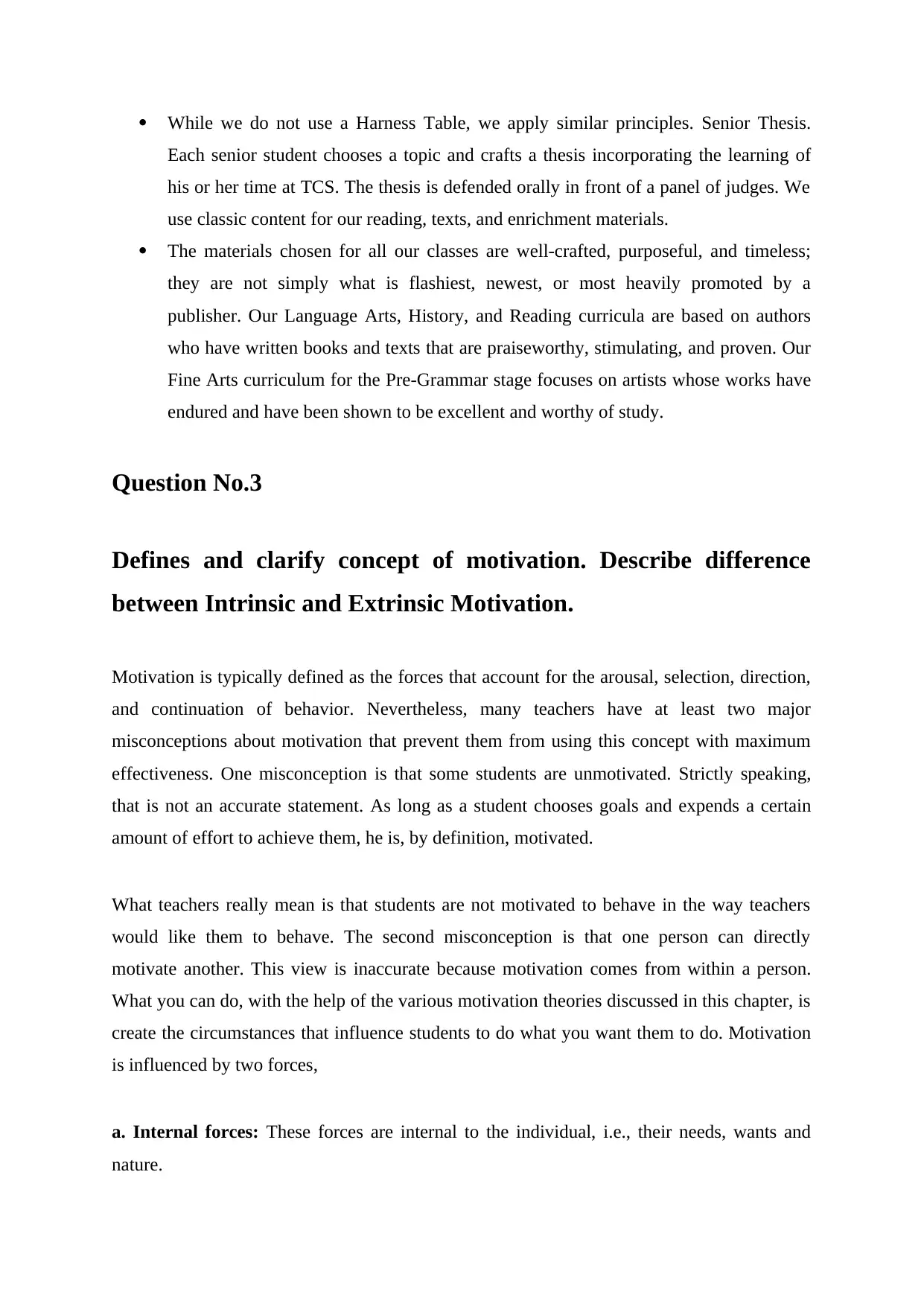
While we do not use a Harness Table, we apply similar principles. Senior Thesis.
Each senior student chooses a topic and crafts a thesis incorporating the learning of
his or her time at TCS. The thesis is defended orally in front of a panel of judges. We
use classic content for our reading, texts, and enrichment materials.
The materials chosen for all our classes are well-crafted, purposeful, and timeless;
they are not simply what is flashiest, newest, or most heavily promoted by a
publisher. Our Language Arts, History, and Reading curricula are based on authors
who have written books and texts that are praiseworthy, stimulating, and proven. Our
Fine Arts curriculum for the Pre-Grammar stage focuses on artists whose works have
endured and have been shown to be excellent and worthy of study.
Question No.3
Defines and clarify concept of motivation. Describe difference
between Intrinsic and Extrinsic Motivation.
Motivation is typically defined as the forces that account for the arousal, selection, direction,
and continuation of behavior. Nevertheless, many teachers have at least two major
misconceptions about motivation that prevent them from using this concept with maximum
effectiveness. One misconception is that some students are unmotivated. Strictly speaking,
that is not an accurate statement. As long as a student chooses goals and expends a certain
amount of effort to achieve them, he is, by definition, motivated.
What teachers really mean is that students are not motivated to behave in the way teachers
would like them to behave. The second misconception is that one person can directly
motivate another. This view is inaccurate because motivation comes from within a person.
What you can do, with the help of the various motivation theories discussed in this chapter, is
create the circumstances that influence students to do what you want them to do. Motivation
is influenced by two forces,
a. Internal forces: These forces are internal to the individual, i.e., their needs, wants and
nature.
Each senior student chooses a topic and crafts a thesis incorporating the learning of
his or her time at TCS. The thesis is defended orally in front of a panel of judges. We
use classic content for our reading, texts, and enrichment materials.
The materials chosen for all our classes are well-crafted, purposeful, and timeless;
they are not simply what is flashiest, newest, or most heavily promoted by a
publisher. Our Language Arts, History, and Reading curricula are based on authors
who have written books and texts that are praiseworthy, stimulating, and proven. Our
Fine Arts curriculum for the Pre-Grammar stage focuses on artists whose works have
endured and have been shown to be excellent and worthy of study.
Question No.3
Defines and clarify concept of motivation. Describe difference
between Intrinsic and Extrinsic Motivation.
Motivation is typically defined as the forces that account for the arousal, selection, direction,
and continuation of behavior. Nevertheless, many teachers have at least two major
misconceptions about motivation that prevent them from using this concept with maximum
effectiveness. One misconception is that some students are unmotivated. Strictly speaking,
that is not an accurate statement. As long as a student chooses goals and expends a certain
amount of effort to achieve them, he is, by definition, motivated.
What teachers really mean is that students are not motivated to behave in the way teachers
would like them to behave. The second misconception is that one person can directly
motivate another. This view is inaccurate because motivation comes from within a person.
What you can do, with the help of the various motivation theories discussed in this chapter, is
create the circumstances that influence students to do what you want them to do. Motivation
is influenced by two forces,
a. Internal forces: These forces are internal to the individual, i.e., their needs, wants and
nature.
Paraphrase This Document
Need a fresh take? Get an instant paraphrase of this document with our AI Paraphraser
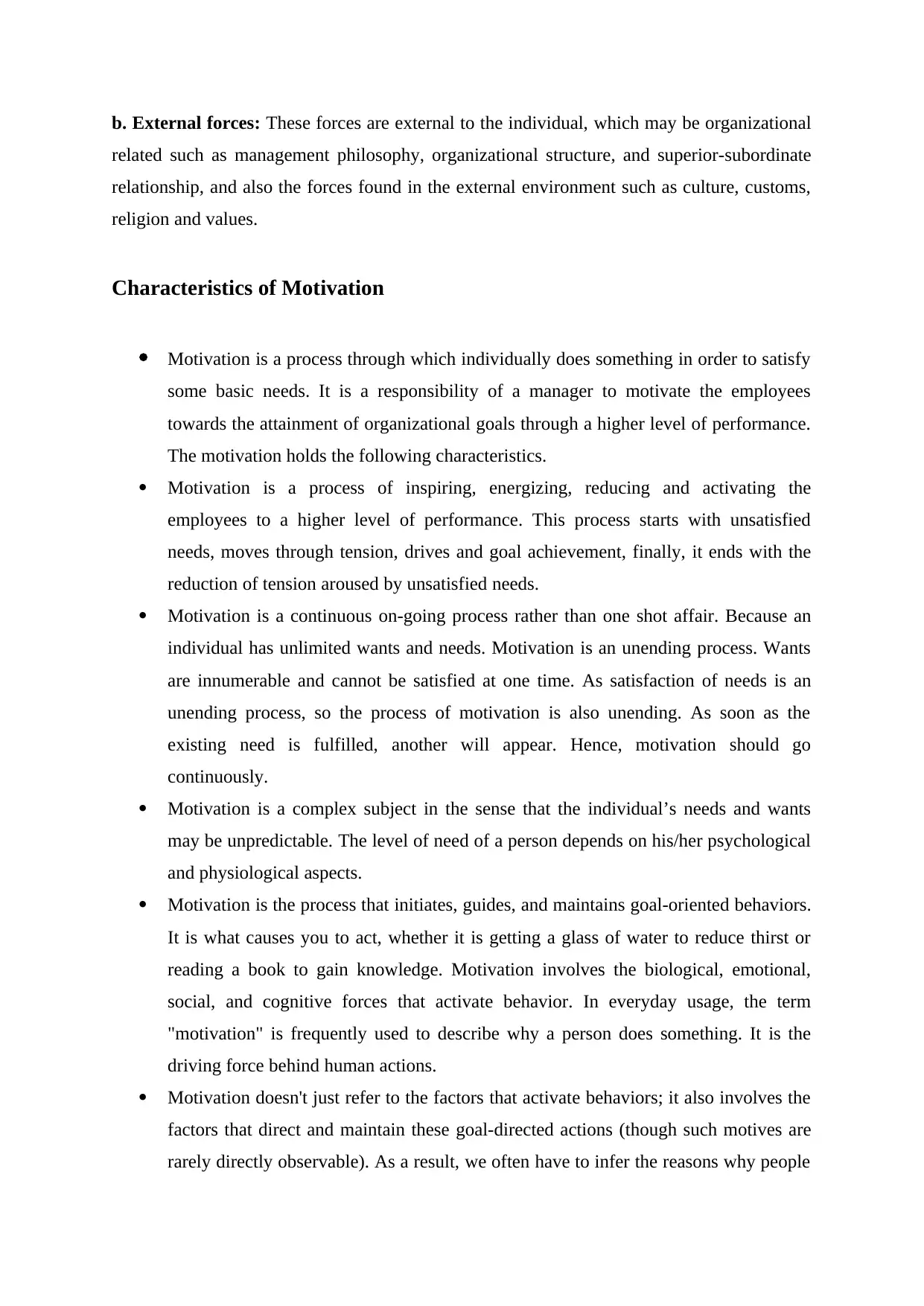
b. External forces: These forces are external to the individual, which may be organizational
related such as management philosophy, organizational structure, and superior-subordinate
relationship, and also the forces found in the external environment such as culture, customs,
religion and values.
Characteristics of Motivation
Motivation is a process through which individually does something in order to satisfy
some basic needs. It is a responsibility of a manager to motivate the employees
towards the attainment of organizational goals through a higher level of performance.
The motivation holds the following characteristics.
Motivation is a process of inspiring, energizing, reducing and activating the
employees to a higher level of performance. This process starts with unsatisfied
needs, moves through tension, drives and goal achievement, finally, it ends with the
reduction of tension aroused by unsatisfied needs.
Motivation is a continuous on-going process rather than one shot affair. Because an
individual has unlimited wants and needs. Motivation is an unending process. Wants
are innumerable and cannot be satisfied at one time. As satisfaction of needs is an
unending process, so the process of motivation is also unending. As soon as the
existing need is fulfilled, another will appear. Hence, motivation should go
continuously.
Motivation is a complex subject in the sense that the individual’s needs and wants
may be unpredictable. The level of need of a person depends on his/her psychological
and physiological aspects.
Motivation is the process that initiates, guides, and maintains goal-oriented behaviors.
It is what causes you to act, whether it is getting a glass of water to reduce thirst or
reading a book to gain knowledge. Motivation involves the biological, emotional,
social, and cognitive forces that activate behavior. In everyday usage, the term
"motivation" is frequently used to describe why a person does something. It is the
driving force behind human actions.
Motivation doesn't just refer to the factors that activate behaviors; it also involves the
factors that direct and maintain these goal-directed actions (though such motives are
rarely directly observable). As a result, we often have to infer the reasons why people
related such as management philosophy, organizational structure, and superior-subordinate
relationship, and also the forces found in the external environment such as culture, customs,
religion and values.
Characteristics of Motivation
Motivation is a process through which individually does something in order to satisfy
some basic needs. It is a responsibility of a manager to motivate the employees
towards the attainment of organizational goals through a higher level of performance.
The motivation holds the following characteristics.
Motivation is a process of inspiring, energizing, reducing and activating the
employees to a higher level of performance. This process starts with unsatisfied
needs, moves through tension, drives and goal achievement, finally, it ends with the
reduction of tension aroused by unsatisfied needs.
Motivation is a continuous on-going process rather than one shot affair. Because an
individual has unlimited wants and needs. Motivation is an unending process. Wants
are innumerable and cannot be satisfied at one time. As satisfaction of needs is an
unending process, so the process of motivation is also unending. As soon as the
existing need is fulfilled, another will appear. Hence, motivation should go
continuously.
Motivation is a complex subject in the sense that the individual’s needs and wants
may be unpredictable. The level of need of a person depends on his/her psychological
and physiological aspects.
Motivation is the process that initiates, guides, and maintains goal-oriented behaviors.
It is what causes you to act, whether it is getting a glass of water to reduce thirst or
reading a book to gain knowledge. Motivation involves the biological, emotional,
social, and cognitive forces that activate behavior. In everyday usage, the term
"motivation" is frequently used to describe why a person does something. It is the
driving force behind human actions.
Motivation doesn't just refer to the factors that activate behaviors; it also involves the
factors that direct and maintain these goal-directed actions (though such motives are
rarely directly observable). As a result, we often have to infer the reasons why people
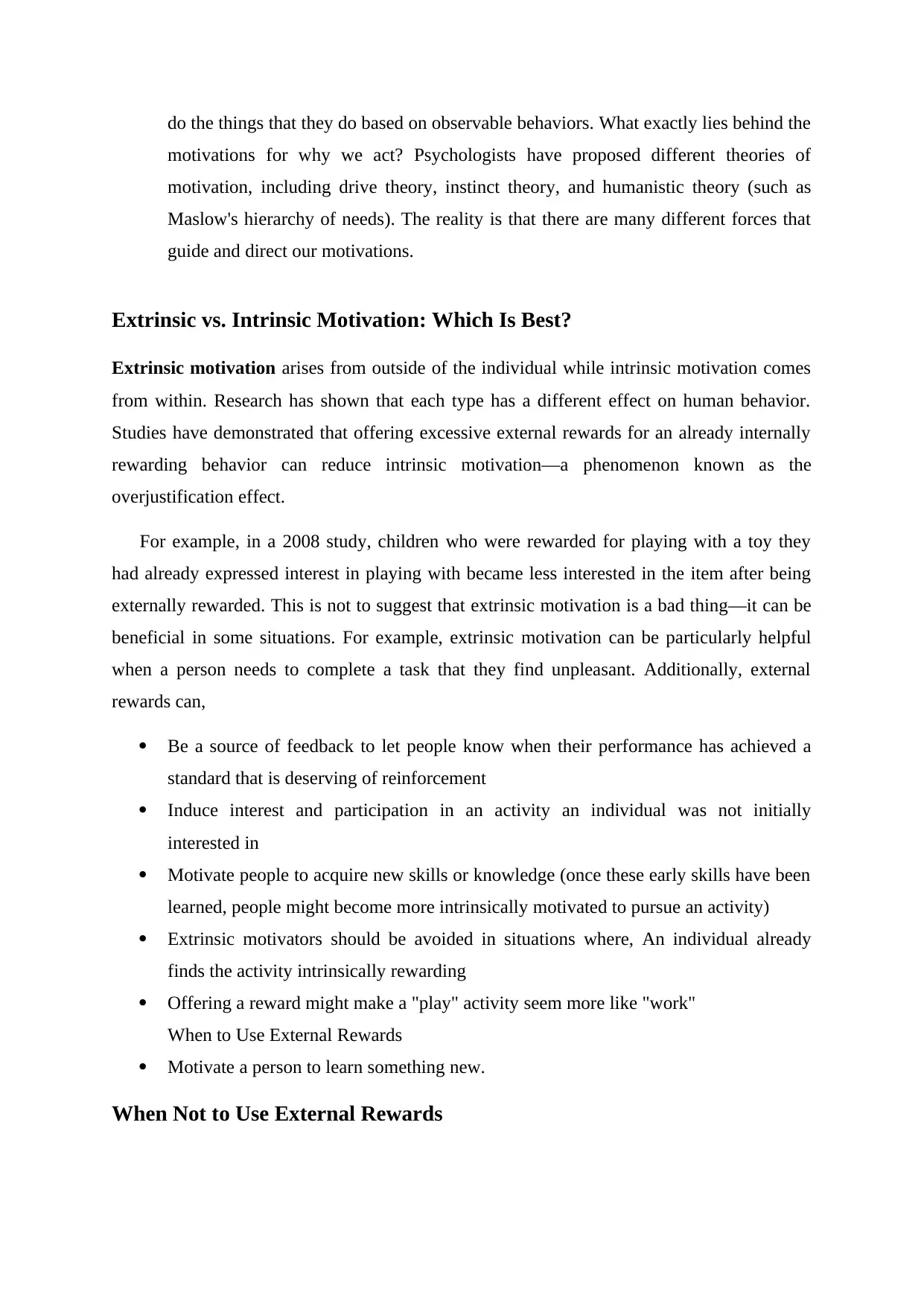
do the things that they do based on observable behaviors. What exactly lies behind the
motivations for why we act? Psychologists have proposed different theories of
motivation, including drive theory, instinct theory, and humanistic theory (such as
Maslow's hierarchy of needs). The reality is that there are many different forces that
guide and direct our motivations.
Extrinsic vs. Intrinsic Motivation: Which Is Best?
Extrinsic motivation arises from outside of the individual while intrinsic motivation comes
from within. Research has shown that each type has a different effect on human behavior.
Studies have demonstrated that offering excessive external rewards for an already internally
rewarding behavior can reduce intrinsic motivation—a phenomenon known as the
overjustification effect.
For example, in a 2008 study, children who were rewarded for playing with a toy they
had already expressed interest in playing with became less interested in the item after being
externally rewarded. This is not to suggest that extrinsic motivation is a bad thing—it can be
beneficial in some situations. For example, extrinsic motivation can be particularly helpful
when a person needs to complete a task that they find unpleasant. Additionally, external
rewards can,
Be a source of feedback to let people know when their performance has achieved a
standard that is deserving of reinforcement
Induce interest and participation in an activity an individual was not initially
interested in
Motivate people to acquire new skills or knowledge (once these early skills have been
learned, people might become more intrinsically motivated to pursue an activity)
Extrinsic motivators should be avoided in situations where, An individual already
finds the activity intrinsically rewarding
Offering a reward might make a "play" activity seem more like "work"
When to Use External Rewards
Motivate a person to learn something new.
When Not to Use External Rewards
motivations for why we act? Psychologists have proposed different theories of
motivation, including drive theory, instinct theory, and humanistic theory (such as
Maslow's hierarchy of needs). The reality is that there are many different forces that
guide and direct our motivations.
Extrinsic vs. Intrinsic Motivation: Which Is Best?
Extrinsic motivation arises from outside of the individual while intrinsic motivation comes
from within. Research has shown that each type has a different effect on human behavior.
Studies have demonstrated that offering excessive external rewards for an already internally
rewarding behavior can reduce intrinsic motivation—a phenomenon known as the
overjustification effect.
For example, in a 2008 study, children who were rewarded for playing with a toy they
had already expressed interest in playing with became less interested in the item after being
externally rewarded. This is not to suggest that extrinsic motivation is a bad thing—it can be
beneficial in some situations. For example, extrinsic motivation can be particularly helpful
when a person needs to complete a task that they find unpleasant. Additionally, external
rewards can,
Be a source of feedback to let people know when their performance has achieved a
standard that is deserving of reinforcement
Induce interest and participation in an activity an individual was not initially
interested in
Motivate people to acquire new skills or knowledge (once these early skills have been
learned, people might become more intrinsically motivated to pursue an activity)
Extrinsic motivators should be avoided in situations where, An individual already
finds the activity intrinsically rewarding
Offering a reward might make a "play" activity seem more like "work"
When to Use External Rewards
Motivate a person to learn something new.
When Not to Use External Rewards
⊘ This is a preview!⊘
Do you want full access?
Subscribe today to unlock all pages.

Trusted by 1+ million students worldwide
1 out of 21
Related Documents
Your All-in-One AI-Powered Toolkit for Academic Success.
+13062052269
info@desklib.com
Available 24*7 on WhatsApp / Email
![[object Object]](/_next/static/media/star-bottom.7253800d.svg)
Unlock your academic potential
Copyright © 2020–2025 A2Z Services. All Rights Reserved. Developed and managed by ZUCOL.



